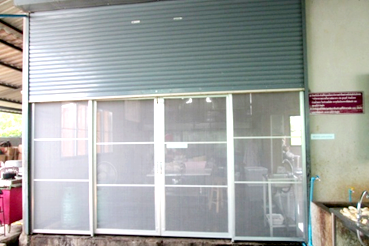Development of Small Halal Food Processing Enterprises in Three Southern Border Provinces to Enhance Food Safety
Main Article Content
Abstract
The development of food production facilities following good food production methods is the basis of food safety management that an entrepreneur needs to build up consumer confidence. The objectives of this project are generating knowledge, understanding the academically correct principles, and developing food production facilities by the standards. The project has involved ten halal food processing enterprises from the provinces of Pattani (4), Yala (4), and Narathiwat (2), producing two types of halal food: ready-to-eat food (fresh rice noodles, rice crackers) and convenience food (Luk-Yee products, Hin banana chips, fish crackers, ginger powder, chilli paste, Nam-Wa banana sticks, and toasted coconut). The research methods are as follows: 1) entrepreneur selection 2) enterprise assessment before project participation, 3) site visit, 4) food processing facility development and 5) enterprise assessment after the operation. The research results show that enterprise assessment scores in all categories meet the standards, and their food products have accredited quality certification with a four-star level (5 enterprises) and five-star level (2 enterprises) from the best of One Tambon One Product (OTOP) selection of the Department of Community Development in 2019. In conclusion, this can ensure that a safety arrangement in the production of all participating food enterprises achieves the standards with potentialities for product development, shelf life research and marketing strategy.
Article Details

This work is licensed under a Creative Commons Attribution-NonCommercial-NoDerivatives 4.0 International License.
Area Based Development Research Journal values copyright protection and licensing to safeguard author rights and facilitate the appropriate dissemination of research. Our policies ensure openness, accessibility, and attribution. Authors retain copyright ownership, and articles are published under a Creative Commons Attribution License (CC BY), allowing sharing, adaptation, and proper attribution. Authors have the freedom to publish under the CC BY license, granting broad reuse and distribution permissions. The journal supports posting articles on third-party repositories, adhering to institutional and funding restrictions. Author guidelines detail copyright and licensing requirements, empowering authors with knowledge about their rights and responsibilities. These policies cultivate an environment of collaboration, openness, and responsible sharing, benefiting authors and the research community while honoring intellectual property rights.
References
Ali, M. H., & Suleiman, N. (2016). Sustainable food production: Insight of Malaysian halal small and medium sized enterprise. International Journal Production Economics, 181, 303-314.
Amoa-Awua, W. K., Ngunjiri, P., Anlobe, J., Kpodo, K., Halm, M., Hayford, A. E., & Jakobsen, M. (2007). The effect of applying GMP and HACCP to traditional food processing at a semi-commercial kenkey production in Ghana. Journal of Food Control, 18, 1449-1457.
Arpanutud, P. (2015). Implementation of food safety management system in Thai small and medium food processing enterprises: Institutional and resource dependence perspective. Journal of Public and Private Management, 22(2), 175-203. (in Thai).
Boonchan, A., Ratiosom, S., & Parinyasiri, T. (2016). Developing ready-to-eat food manufacturers’ readiness to follow good manufacturing practice regulation in Samut Sakhon. Electronic Journal of Open and Distance Innovative Learning, 6(1), 91-113. (in Thai).
Charalambous, M., Fryer, P. J., Panayides, S., & Smith, M. (2015). Implementation of food safety management systems in small food businesses in Cyprus. Journal of Food Control, 57, 70-75.
Chokratanachai, W., & Klomjoho, S. (2017). Sustainable development of crispy rice production for commercial food production standards by community participation. Area Based Development Research Journal, 9(1), 8-22. (in Thai).
Community Development Department. (2019). Manuals and guidelines OTOP product champion: OPC. Retrieved June 5, 2020, from: http://singburi.cdd.go.th/wp-content/uploads/sites/65/2019/06. (in Thai).
Dzwolak, W. (2014). HACCP in small food businesses: The polish experience. Journal of Food Control, 36, 132-137.
Fielding, L., Ellis, L., Clayton, D., & Peters, A. (2011). An evaluation of process specific information resources, aimed at hazard analysis, in small and medium enterprises in food manufacturing. Journal of Food Control, 22, 1171-1177.
Halal Institute Prince of Songkla University. (2011). Practices for Halal food production. Retrieved October 22, 2020, from: http://www.halinst.psu.ac.th/th/knowledge-th/knowhalal-th/110-any-practice-of-halal-food-production.html. (in Thai).
Hasnana, N. Z. N., Aziza, N. A., Zulkiflib, N., & Taip, F. S. (2014). Food factory design: Reality and challenges faced by Malaysian SMEs. Journal Agriculture and Agricultural Science Procedia, 2, 328–336.
Pornchaloempong, P., & Rattanapanone, N. (2020). Good hygiene practices. Retrieved October 20, 2020, from: http://www.foodnet worksolution.com/wiki/word/3439/good-hygiene-practices-ghp. (in Thai).
Prommaroeng, S. (2018). The elevation approach of OTOP’s foods which produced in Mae Ban Rim Rong community enterprise of Makeujae sub-district, Muang district, Lamphun province. Journal Social Science Srinakharinwirot University, 21, 248-258. (in Thai).
Ruangkalapawongse, A., Ruangkalapawongse, S., & Sripong, V. (2012). Environmental factors affecting the competitiveness of the processed fruit and vegetable industry in the lower central region of Thailand. SDU Research Journal Humanities and Social Science, 8(1), 119-130. (in Thai).
Sirinon, J. (2019). Development potential entrepreneurial orientation for competitive advantage of producer groups OTOP Buriram province. Electronic Journal of Open And Distance Innovative Learning, 9(2), 31-37. (in Thai).
Srikaeo, K. (2013). Quality management in the food industry. Bangkok: Chulalongkorn University Press. (in Thai).
Yapp, C., & Fairman, R. (2006). Factors affecting food safety compliance within small and medium-sized enterprises: implications for regulatory and enforcement strategies. Journal of Food Control, 17, 42–51.


